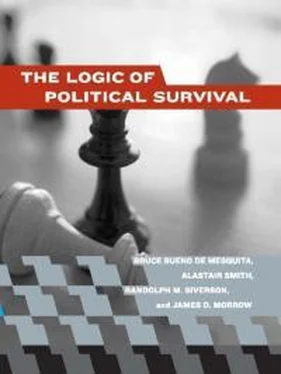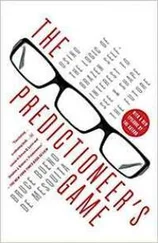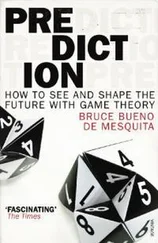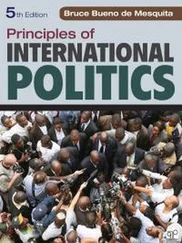Members of the selectorate then cannot be certain that the challenger seeks their aid because of their mutual affinity or simply as a means to come to power. Potential defectors from the winning coalition feel this uncertainty most deeply. They understand the bonds of affinity with the current leader but cannot be certain about those with the challenger. The challenger has every incentive to tell potential defectors anything if it will encourage them to defect and help him topple the sitting leader. Only if the challenger comes to power will he reveal his true affinities when he is free to place those he likes—as opposed to those he needed to come to power—in favored positions.
This difference in the shared knowledge of affinities between leaders and followers creates an incumbency advantage, an advantage that may be large or small depending on how valuable membership in the winning coalition turns out to be. That value depends primarily on the size of the coalition and the size of the selectorate, not on affinity.
The degree of the heterogeneity of affinity within a society can be thought of as a measure of the distribution of values. Societies with homogeneous cultures, for instance, are likely to have less variance than others in the affinity ordering from one political leader to the next simply because the homogeneous culture probably creates a selection effect. Individuals without the socially preferred set of characteristics are unlikely to be contenders for high office. In heterogeneous societies candidates probably are more diverse in their appeal to individual choosers and so feel different degrees of affinity for different sectors of the society. In that sense, affinity is more dispersed in such environments, so that once challengers gain a secure hold on office, they are likely to assemble their winning coalition from a quite different group of people than did the erstwhile incumbent.
In our model, decisions are made based on affinity only if everything else is exactly equal. In other words, the affinity effects are very small in magnitude. The proofs we offer in the appendix to chapter 3 are based on the convenient assumption that affinities are smoothly distributed across selectors. That is not necessary for the theory, but it does make the mathematics much simpler. We also make affinity a property of leaders for followers rather than one of followers for leaders. Although we believe that bonds of affinity flow in both directions, our assignment of affinity to leaders simplifies the mathematics of the model without altering its conclusions. We digress now to offer some conjectures about what we believe happens if affinities are distributed in a lumpy or correlated way. Since they do not influence our analysis, we leave efforts to evaluate these conjectures to future research projects.
In societies that have many substantial groups, affinity is likely to be lumpy in its distribution. Here we have in mind that leaders may choose to reward potential followers on the basis of bloc identity, creating ethnic, religious, or other forms of group “voting” of the sort that characterizes elections in many Indian states, or voting in the days of New York’s Tammany Hall or Mexico under the PRI, with its close ties to the labor movement. Of course, such lumpy affinities are also especially common in rigged electoral systems such as prevail in Iraq or Zimbabwe. Lumpiness in affinity may have the potential to create what are effectively small winning-coalition systems even though the legal or constitutional system dictates majority rule. The idea is that a few key individuals—members of the winning coalition—can deliver bloc votes, much as the Returning Officer did in the Kenyan example offered earlier. In a similar way, labor union leaders in Mexico, the United States, and France for long periods could muster the support of the vast majority of their membership for whichever national candidates they endorsed. Recall that the loyalty norm approximates W / S as the number of essential coalition members approaches zero. However, as the proportion of coalition members who are “essential” increases, then even though the nominal size of W might be large, the effective size is smaller. This is, we believe, the key characteristic of lumpy or correlated affinities. They create bloc leaders—essential coalition members—who collectively deliver the requisite number of nominal coalition members—who reduce the size of the actual winning coalition.
If affinities are highly correlated across individuals within groups, the candidate’s selection by a single member of the group can serve as a signal to all members of the group. Members of the group follow the lead of their bloc leader in choosing how to vote. This means that a candidate who can gain a group leader’s support can count on the group leader to deliver a bloc of votes, a phenomenon especially common in settings in which patron-client relations are strong. Such a circumstance makes it relatively inexpensive to buy support among a few members of large groups, thereby ensuring the reality of a small winning coalition with the appearance of dependence on a large coalition. Generally, such bloc affinities are based on clearly known social categories, such as ethnicity or union membership, so that potential followers know who will be included in the winning coalition if their bloc comes to power. In this way, blocs can reduce the commitment problem that the challenger faces.
It is important to note that the selectorate theory does not require the affinity variable. We can and have constructed models of the theory that do not include affinity (Bueno de Mesquita and Siverson 1997; Bueno de Mesquita et al. 1999). These models lead to the same fundamental insights, though the mathematics can be more complicated than when affinities are included. However, we include affinity because it serves two purposes in our model.
First, it serves a technical convenience that simplifies solving the game. The theory depends on members of the incumbent’s winning coalition having a higher probability of being in the winning coalition in the future than do members of the challenger’s coalition or any other members of the society. That is, while the incumbent can credibly commit to continue to maintain the composition of her winning coalition once she is ensconced in power, the challenger cannot credibly commit to keep everyone in his transition coalition. As he learns about affinities, he rebuilds his coalition to include the highest-affinity individuals because he can credibly commit to retain them once he is ensconced in power. Affinity sharpens this distinction by allowing us to fix the probability as W/S that an individual will make it into the permanent winning coalition if the challenger wins office, while fixing the probability of continuing in the incumbent’s winning coalition if one already is in it at 1.0. We do not require this stark a difference and it does not produce any of our results. The results depend on the latter probability being higher than the former without regard to how much higher it is.
Second, affinity also plays a substantive role. It allows us to capture the idea that the coalition that sweeps a new leader into office rarely is the same as the coalition that the leader uses to stay in power. We represent this switch between a transition coalition and the subsequent permanent coalition in the stylized form of revelation of affinities. Additionally, we believe, as suggested earlier, that alternative assumptions about how affinities are distributed can expand the generality of our theory to encompass important features of ethnic, religious, labor union, or other group politics. This permits us to explain why some apparent democracies—like New York City under Tammany Hall, Mexico under the PRI, or India with patron-client voting—engage in corruption and other activities more characteristic of autocracies than democracies.
Читать дальше












